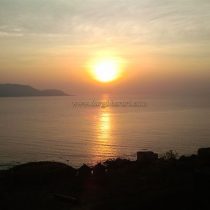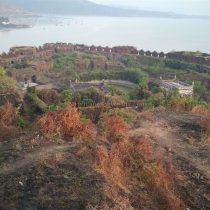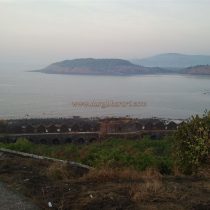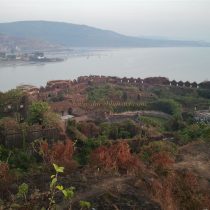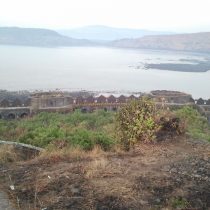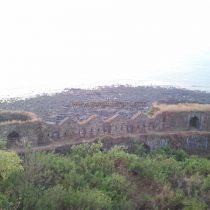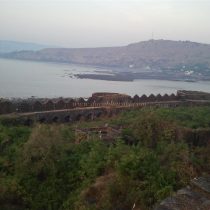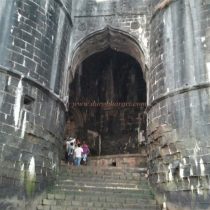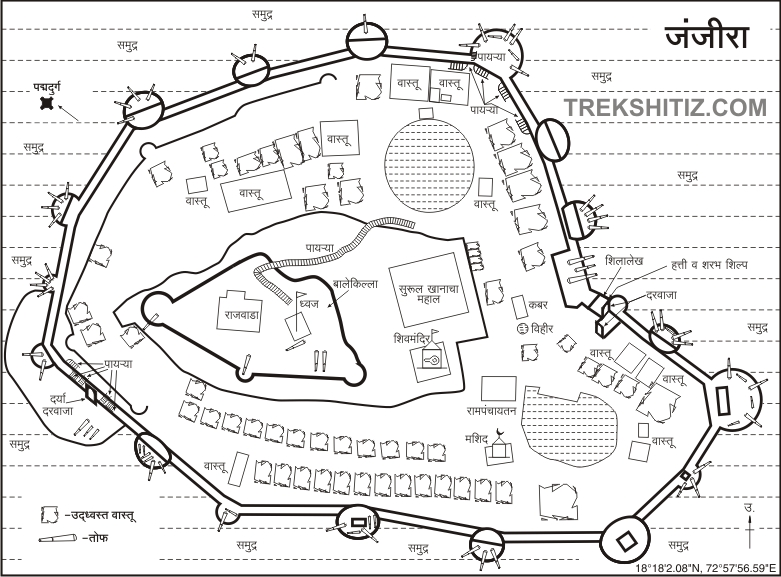JANJIRA
TYPE : SEA FORT
DISTRICT : RAIGAD
HEIGHT : 0
GRADE : EASY
The second most beautiful fort in Maharashtra after fort Sindhudurg is fort Mehrub aka fort Janjira. Located near Mumbai-Pune, this fort is well known among tourists for its huge cannons and the natural beauty surrounding it. There are many tourist and historical sites on this beautiful beach. To reach the water fort of Janjira, one has to reach Alibag via Pune and Mumbai. Murud can be reached from Alibag via Revdanda. At a short distance from Murud are Danda and Rajpuri villages which are four to five kilometers away from the seashore. To the west of this Rajpuri village, at the mouth of the Rajapuri creek in the sea, stands the invincible Mehrub fort aka Janjira fort. One of the reasons why this fort remained invincible is said to be that the foundation of this fort was laid at a very auspicious time. Boats are available from Murud village and Rajpuri village to reach the fort.
...
It takes half an hour to reach the fort from the shore. The boat coming from Rajapuri village stops at the steps of Janjira fort’s gate. The fort is built on 22 acres of land using stone, lead, and lime. Its main door is very huge and beautiful. If you look at the signs of the seawater on the main door, you can easily guess where the water reaches during the high tide. The ramparts of Janjira are elevated. The main gate of the fort is on the east side towards the shore and is supported by two bastions. We enter through the stone steps that are regularly washed by the sea. Near the main entrance is a Persian inscription in white stone. Adjacent to this door is two sculptures carved. The first of these sculptures depict a Sharabh carved holding a total of six elephants, one each in four legs, one in the tail, and one in the mouth. On the left is a sculpture of a tiger and a lioness. There are guard porches in the area between the two gates. The town hall at the entrance of the fort is still in good condition. Upon entering the fort, there is another door on the left. To the right of this door is a barn-like structure. This is called Pir Panchayatan. There are 5 Pirs in this building. It is said that there was a temple of Ram here before Siddi conquered this fort. There are some structures next to this panchayatan. This is where the three anchors of the ship lie in a rusty state. As you proceed towards the front of the Pir Panchayatan, you see horse stables. On the hummock in front of this stable, there is a 3 storey dilapidated building called Surulkhan's mansion. The Palace which was in good condition until very recently has now suffered a major setback. To the north of this fort is a large sixteen-cornered lake. The circumference of this lake is about 70 feet. The entire fort was supplied with water from this lake. There are four cisterns at the four corners of the lake and the water from them is drawn directly into the adjoining mansion. Besides, there is another lake on the fort. The lime plastered building behind the citadel is said to be the headquarters of the fort. After going up the newly built steps by the side of the lake, we reach the citadel. The entire fort can be seen from this part of the citadel. There is a small gate on the west bank of the fort and this gate is known as Darya Darwaza. Outside this gate is the original jetty built for the boat coming to the fort. It was used to get out in times of crisis. There are also some tombs next to it. Above this gate was the fort's prison near the ramparts. Apart from this, the remains of sculptures in Hindu temples are seen scattered in some places. A Shiv temple has been found in this fort during the recent excavations of the Archaeological Department. After seeing the interior of the fort, come back to the main gate. From here, as you go up the steps leading to the fort’s ramparts, you can see three magnificent cannons placed to guard the front gate. Their names are Kalal Bangadi, Chawri, and Landa Qasim. The Kalalbangadi cannon was brought by the Peshwas to attack Janjira. But their attempt failed and they had to hold back the huge cannon. There are 22 small and big bastions in the ramparts of the fort and most of them have cannons mounted on them. Each bastion is 80 feet in circumference and 30 to 45 feet high. The distance between the two bastions is more than 95 feet. The ramparts have arches. In that arch are placed cannons facing the sea. On the other bastions, there are approximately two to seven arches, so considering this there are more than one hundred and fifty cannons on the fort as of now. It is mentioned that there are 514 cannons on Janjira. The fort used to have three localities. Two of these localities belonged to Muslims and one to others. The fort used to have a large population. After Independent, all the settlements shifted outside the fort. A wide area is visible from the ramparts of Janjira. Kasa fort aka Padmadurg in the sea and Samrajgad on the coast can also be seen from this fort. Looking at Janjira fort, which has remained impregnable and invincible for 330 years, many episodes of the history of the fort disappear before our eyes. A visit to Janjira after studying a little bit of history will make it memorable. It takes at least four hours to see the entire fort. There is no doubt that Janjira is a beautiful fort that dominates the western seas. Janjira was under the rule of an independent Koli king. The fort remained independent till 1490, even after the fall of the Yadav kingdom and the arrival of the Sultanate. The island formerly had a wooden fort. At that time Rajpuri was mainly inhabited by the Koli people. These Koli people were always harassed by robbers and pirates. so far this wooden fort was built on the island to protect from these robbers. The rampart of this wooden fort was built of large wooden logs adjacent to each other. Koli’s lived safely in these ramparts. At that time, Ram Patil was the head of all the Koli people. At that time, the permission of Nizami Chief had to be sought for the construction of the wooden fort. As soon as they got permission to build Medhekot, Ram Patil became the Chief of this area. In 1485, Malik Ahmed of Junnar tried to conquer Janjira, but as the fort is very difficult to defeat and also due to the power of Ramrao Koli, Malik gave up. Later on, the Nizamshah appointed Piramkhan to conquer it. Piramkhan had an idea that Ram Patil would not even let him wander anywhere near Medhekot. Piram Khan was very clever. Four years later, a merchant ship was anchored near the fort. Perimkhan and his Siddi soldiers pretended to be merchants from Surat and sought refuge in the fort. As soon as the fort chief Etbarrao gave his approval, the goods of Perimkhan along with his soldiers came to the fort. While all the Koli’s were drunk at night, Perimkhan and his army from the rest of the ships attacked and killed everyone on the fort. The fort came under the control of Nizam Shah of Ahmednagar (1490). Nizam Shah upgraded the fortifications on the fort from 1567 to 1571. Nizam Shah handed over the responsibility of the fort to Siddi and renamed the fort as 'Janjire Mehroob'. Later, in 1617, Siddi Amber obtained independent power from the emperor and became the Chief. He is played a major role in Janjira Sansthan. The first campaign of Janjira was given by Shivaji Maharaj to Raghunath Ballal Sabnis on 14th August 1657 but this first campaign of Swarajya failed. In May 1669, Shivaji Maharaj himself launched an expedition. The plan was to infiltrate Danda-Rajpuri with infantry and Janjira fort with the help of the navy. Janjira's Chief was Fateh Khan and under him were Sambul, Qasim, and Khairyat. Fateh Khan himself was in Danda-Rajpuri. There were seven other forts in his territory. The infantry had captured all the seven forts of Fatehkhan one after the other. Janjira's Kalal Bangadi cannon was worth nothing in front of the Marathi army. Due to the capture of Danda-Rajpuri, Janjira was besieged from all sides. Fateh Khan wrote a letter to the British of Mumbai for help, but the senior British at Surat advised the British of Mumbai to remain neutral rather than to take action against Shivaji Maharaj. (June 1669) Siddi requested the Mughals, according to which Shivaji Maharaj was ordered to remove the siege. However, ignoring the order, Maharaj strengthened the siege. Maharaj had realized that Fateh Khan was trapped, their stay was near Pen (November 1669). Shivaji Maharaj respectfully informed Fateh Khan that in return for handing over Janjira to us, we would give you a large sum of money as compensation and also give you the respect you deserve in the Swarajya. Fateh Khan Siddi agreed to this but other siddhi militants in the fort oppose this. They imprisoned Fateh Khan and took possession of Janjira fort. Siddi Sambul became the chief of Janjira and Siddi Qasim and Siddi Khairat became the fort keeper and constables of Janjira respectively. He appealed to Aurangzeb to remove the insignia of the court of Bijapur. Aurangzeb's army increased due to this, he canceled the title 'Wazir' on Siddi's throne and gave him a new title of 'Yakutkhan' and gave all of them three Jahagirdari as well as ships from Surat in December 1669. The expedition of 1669 failed, but Shivaji Maharaj had well-fortified the conquered territory and had prepared a convoy of armed ships at Danda Rajpuri. Around 1671, Shivaji Maharaj resumed the campaign of Janjira. He had decided to give a reward of 16 kg of gold to whom-so-ever wins the fort of Janjira. Maharaj's base was on three corners from Janjira. On the same night, Siddi Qasim was preparing to carry out a silent attack on Danda Thane (February 10, 1671). Samrajgad was a fort on the coast. Marathi's army was stationed in the fort. Qasim had planned to attack Siddi Qasim by sea and Siddi Khairat by land. As it was the festival of Holi, the army inside the fort was unconscious except for the patrol soldiers. As soon as Qasim's boats reached the fort wall, Khairat attacked the fort. All the army on the fort started to defend against the attack from the land done by Khairat and no one was paying attention towards the sea route. Qasim's army came onto the fort with ladders and conquered the fort.The fort was divided between Khairat and Qasim & patrol troops were defeated. Meanwhile, a huge explosion took place in the ammunition depot at the fort. Huge smoke billowed. The battle was ended but Danda-Rajpuri went back to Siddi from Swarajya. On the island beyond Janjira, Shivaji Maharaj started the dream of building Padmadurg. The biggest obstacle in the construction of the fort was the rain of cannons coming from Janjira fort. But still, the work continued. Meanwhile, the coronation ceremony of Maharaj was completed. Shivaji Maharaj resumed the campaign of Janjira, increasing the strength of the army. Siddi invaded Vengurla and set it on fire. The Marathi fleet chased Siddi from Rajapur and Vijaydurg but he escaped and reached Janjira. Janjira was then surrounded by the Marathi army. Marathi cannons started firing towards Janjira fort. Siddi Sambul wasn’t present inside the fort at the time of the attack, he had gone to Vengurla, he returned to the fort with his army and broke the siege. In August 1676, Moropant launched the Janjira campaign. At this time Siddi Qasim was returning from Surat to Janjira with an army. The cannons of the Marathas started firing again on Janjira. The ramparts of Janjira were very strong, the shots fired from the cannons did not affect them much. Moropant was making endless efforts and suddenly a bold idea came to his mind.They decided to climb the Janjira fort with ladders and defeat Siddi's army. Lai Patil took the responsibility of doing this. Lai Patil had to put ladders on the ramparts and Moropant had to raise the army of twelve thousand from the shore. After midnight, Lai Patil and his companions took ladders in small boats and reached the ramparts of Janjira silently, evading the guards on the top of the ramparts. In the darkness, there was only the sound of the sea waves crashing against the ramparts. Lai Patil was waiting patiently for Moropant's detachment. Time was running out although Moropant and his army didn’t reach there. It was a matter of time before the coast patrols would spot them and kill them. Lai Patil did a great job evading and hiding from the enemy but Pant did not seem to be anywhere. The time had come in the morning, if the ladders were not removed, the patrol would have been spotted it and got alerted and this plan would never have succeeded again. Despite numerous tries of Lai Patil, Moropant never reached the ladders with his companions and Lai Patil had to retreat. What exactly happened to Moropant? Whose fault was it? Only history knows this. The Moropants themselves acknowledged the failure of the campaign. When Shivaji Maharaj came to know about this incident, he called Lai Patil to honor him. But the faithful servant of Swarajya humbly denied the honor. Appreciating this, Shivaji Maharaj issued an order to build a ship for Lai Patil and named it "Palkhi". Shambhu Maharaj also tried to conquer Janjira in 1682. Just as Lord Ramchandra built the bridge Ramsetu to invade Lanka, so Sambhaji Maharaj built a 2500 feet bridge in the rising sea. The enemy from Janjira fort would come out, catch people on the shore, cut off their ears and noses and kidnap their women and children. The people who were troubled by this persecution came to Shambhu Raja and told him about their problems. Hearing all these horrible things, Sambhaji Raje became very angry and they decided to attack Siddi. They knew that Janjira was difficult to win in a straight fight because the turbulent sea was there to help Janjira. They attacked Janjira with an army of twenty thousand soldiers and three hundred ships. Sambhaji Maharaj's cannons fire started from the shore. The cannons of the Marathas were reaching till the fort. But at the time sea came to Janjira's aid. Due to high tide, Maratha soldiers began to move backward. But Shambhu Raje did not stop. They decided to build a bridge across the sea. Work began, the bridge began to take shape. As soon as the Maratha’s started firing their cannons, at the same time, Aurangzeb sent a chief named Hasan Ali to the headquarters of Swarajya. Hasan Ali, the chief of Aurangzeb, had started marching towards Raigad via Kalyan-Bhiwandi with an army of 40,000. Therefore, the expedition was halted and Shambhaji Maharaj had to return to Raigad to defend his Swarajya. For the last three and a half centuries, no one has been able to conquer this fort, no matter how big or small the enemy is. The fort was truly impregnable for three reasons - the turbulent sea, the fortifications, and the perseverance of Siddi. It is safe to say that this fort was the only reason for the survival of Siddi's kingdom in this area. It was a wonderful fort in Siddi's group. In the area of Murud Rajapuri, Siddi could easily do whatever he wanted and hide in a tortoise shell-like fort whenever the enemy approached. From the point of view of the navy, it is difficult to find a more useful place. From this fort at the mouth of Rajapur Bay, one could observe the trade-in Danda and Rajapuri ports. The Marathas tried to capture the fort at least ten or twelve times but unfortunately, none of them succeeded. Remains of some historical structures can still be seen in the vicinity of Murud. The historic palace in this village is known as 'Nabawacha Rajwada'. Even though the palace is old, its grandeur and the beauty of its construction still amaze us. But it is prohibited to go inside. To capture the Janjira fort, Shivaji Maharaj had built another fort called Padmadurg at a distance of about five or six km from the Janjira fort. But still, Shivaji Maharaj couldn't win the Janjira fort. Janjira Sansthan was invincible till the reign of Siddhi Muhammad Khan. He was the last ruler of Janjira Sansthan. After this, the Janjira Sansthan got annexed into the independent Bharat on 3 April 1948.
© Suresh Nimbalkar

